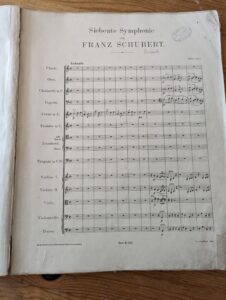
Schubert never heard this work performed, indeed it was nearly lost to the world until Robert Schumann discovered the manuscript and brought it to Felix Mendelssohn, who was a great champion of Schubert’s works. Mendelssohn arranged for the premiere of the symphony in 1839, eleven years after Schubert’s death. After the performance, Robert Schumann wrote this review of the work:
Here, besides sheer musical mastery of the technique of composition is life in every fibre, colour in the finest shadings, meaning everywhere, the acutest etching of detail, and all flooded with a Romanticism which we have encountered elsewhere in Franz Schubert. And this heavenly length, like a fat novel in four volumes by Jean Paul—never-ending, and if only that the reader may go on creating in the same vein afterwards. . . . It is still evidence of an extraordinary talent that he who heard so little of his own instrumental work during his lifetime could achieve such an idiomatic treatment both of individual instruments and of the whole orchestra, securing an effect as of human voices and chorus in discourse. . . . The brilliance and novelty of the instrumentation, the breadth and expanse of the form, the striking changes of mood, the whole new world into which we are transported—all this may be confusing to the listener, like any initial view of the unfamiliar. But there remains a lovely aftertaste, like that which we experience at the conclusion of a play about fairies or magic. There is always the feeling that the composer knew exactly what he wanted to say and how to say it, and the assurance that the gist will become clearer with time.
Mendelssohn arranged for publication of this symphony and tried to set up further performances. But he met with resistance from both audiences and players. Audiences were not used to hearing works on such a monumental scale, and it would not be until the romantic era that such length would become accepted. Players found the work technically demanding and exhausting – and the performance of this work remains a challenge to this day.
Orchestra of Square Chapel couple this work with the rarely-performed reconstruction of the first movement of Beethoven’s Tenth Symphony. Concert details are here.
